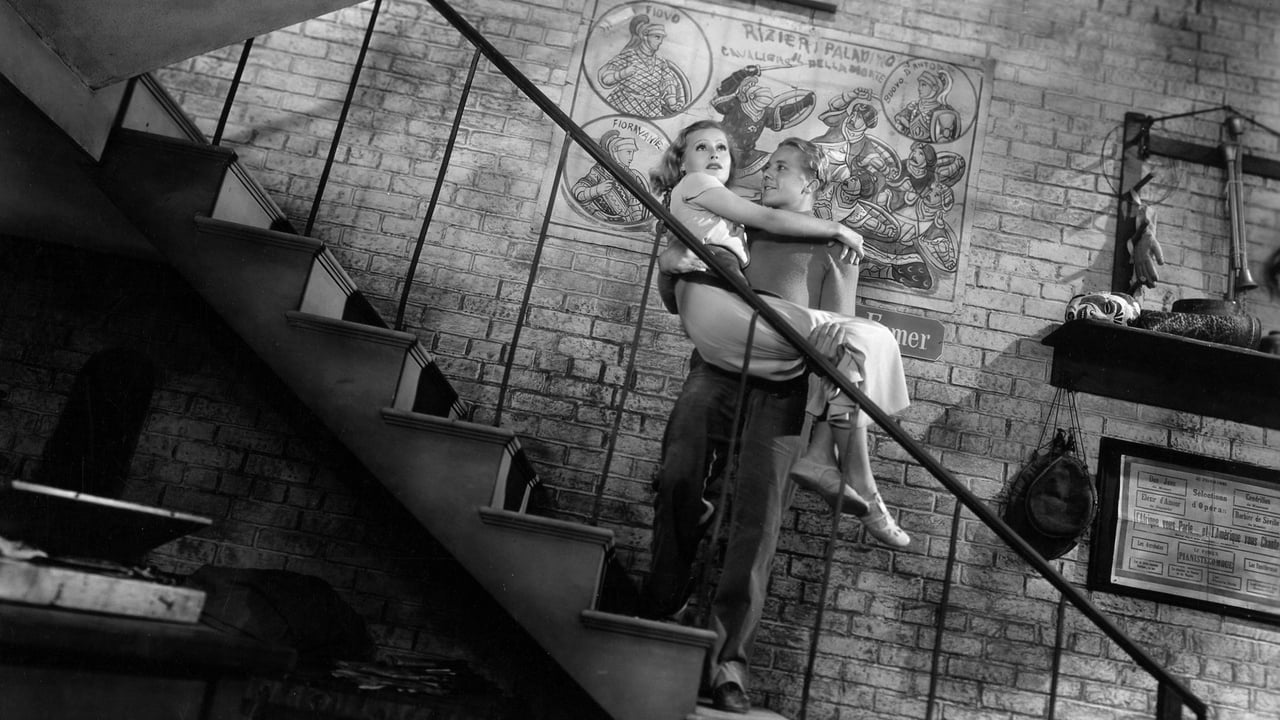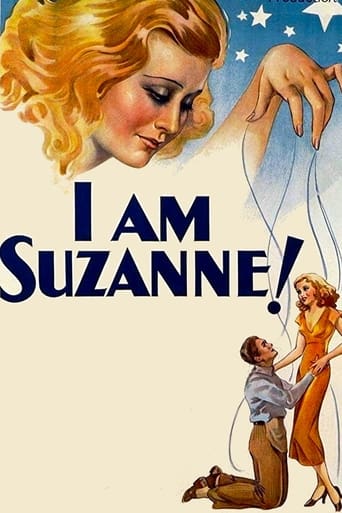



Slow pace in the most part of the movie.
Just perfect...
It isn't all that great, actually. Really cheesy and very predicable of how certain scenes are gonna turn play out. However, I guess that's the charm of it all, because I would consider this one of my guilty pleasures.
View Moreit is the rare 'crazy' movie that actually has something to say.
View MoreA friend just sent me a great copy of this film. It is black and white, but primarily sepia-colored when the stage performances are shown.From the first I felt an empathy for poor Suzanne who practiced for hours and was forced by her manager (well-played by Leslie Banks) to isolate from fans or friends. Her helper, "Mama", was in sympathy, but was out for what she could get. She tirelessly keeps Suzanne practicing her ballet steps.When Suzanne meets Tony the puppeteer, her manager throws him out, as he fears she will leave the act. He is jealous in a personal sense as well. Even when Tony explains he wants to sketch a puppet of Suzanne, The Baron gets angry. Though he never appreciates her fine singing voice and her lovely stage dancing, he is quick to pocket a lot of Suzanne's earnings. He also uses psychology on Suzanne to get her to marry him. Hinting that she will be without her act if she does not, Suzanne is afraid to give up her dancing and singing. She almost tearfully asks "the Baron" to marry her and it is arranged.When Suzanne (beautifully portrayed by Lillian Harvey) sang and did her stage performances, I felt pleasantly surprised by the lovely intertwining harmonies supplied by the puppeteers, who had their people sing and dance with lovely precision. The singing voices are reminiscent of the haunting harmonies of the voices in Merrie Melodies cartoons of the 30s and also films I love of the early 30s.When Suzanne is doing her act "flying through the air" from the audience to the stage, Tony begs her not to marry the Baron. Thus, she recognizes feelings for him which cause her to miss-step. As she falls and ends up in hospital, Suzanne is encouraged by the doctor and Tony daily. Tony helps with her exercises and Suzanne is recovering. She does not wish to marry the Baron and tells him so.I have not seen many puppet performances, but these are superb! The dancers are perfect replicas of Tony and Suzanne and dance beautifully in time to the music. I do like The Puppet People and a film with Lionel Barrymore where he wreaks vengeance on people, shrinking them to doll size. These are skillfully done, but show the real people in close-ups as well as the puppets.In I Am Suzanne, we see more close-ups of the puppets. AS reviewers have already pointed out, Suzanne is confused about Tony's feelings when he proposes to her through the life-like puppet he has made of himself (and her). Later he explains that she, as a star, was an ideal to him. He never thought he would be close enough to propose marriage to her.I will not spoil the denouement of the film for others. I think it is time well spent.
View MoreAfter he lost out in a power struggle at Paramount, Jesse Lasky went to Fox, where he produced some innovative pictures that were not particularly successful at the box office. This is one of them.Most of what is interesting about this movie is the opportunity to see the handiwork of a couple of marionette companies of the era. Otherwise, there is one clear case of miscasting (Gene Raymond is supposed to be the neurotic scion of five generations of puppeteers who has a better relationship with his puppets than human when he looks and acts like a college football star) and some more subtle mistakes in acting and directing: Lilian Harvey is directed in the opening scenes as so withdrawn that I thought she might be playing an idiot, but as she gains in self control and knowledge, she becomes audible. Leslie Banks is quite amusing in a brief foray into the colonies and Georgia Caine handles the confidante-out-for-herself role very well.Although this is a visually striking film, there are script problems. There is an interesting subtext about the relationship of identity and control as various people insist that they are Suzanne, the Lilian Harvey character, before the matter is sorted out. Had the film makers had a little more confidence in their audience, this might have turned into a better movie.
View MoreA few weeks ago, I stumbled across an old VHS documentary about the famed - in the puppetry world - Yale Puppeteers and their Turnabout Theatre. The documentary discussed how, in the early thirties, they had been asked to create a marionette sequence for a Hollywood film. The tape also showed a few scratchy but tantalizing scenes from the movie that included an elaborately staged musical sequence, some sort of trial run by Satan and some cameos by marionette versions of the Marx Brothers and Charlie Chaplin. Having an interest in puppetry . . .I needed to find that film. After an exhausting thirty seconds of google-ing, I found the name of the film, the stars and the fact that it seemed to have fallen into public domain and out of print. Luckily, some enterprising gentleman - and there seem to be many - had managed to get what appeared to be an old VHS copy of the film burned onto a DVD and was selling it on Ioffer. I offered and it arrived a few days later. I would have preferred that the quality of the DVD had been better, but I was able to watch it. Obviously a "B" picture, but still very enjoyable. As has been noted by other reviewers, Miss Harvey plays Suzannne, the main dancer and star attraction in a Paris theater. She is, in most ways, the puppet of her manager who tells her what and when to do everything and controls every aspect of her life, even attempting to control who and how she loves. Tony is a puppet-master at a failing, small theater nearby. Tony's whole life revolves around puppets to the point that it is the only way he can deal with people: as puppets. He even resorts to using a puppet to get to know Suzanne after he becomes smitten with her.When an accident changes circumstances for Suzanne, she develops a closeness to Tony and, at one point, becomes his puppet. But, after a fun little dream sequence and a sort of puppet trial, Suzanne manages to sever the strings but maintain the connections and Tony learns that people aren't puppets. As one would expect since its 1933, all ends well.The film suffers from the limited budget, a script that is never quite as good as its concept and themes and by a lead actress who is decent, but not great. There are, though, some fascinating dance sequences where Miss Harvey is thrown around the stage like a puppet. The marionette work is lots of fun with glimpses of performances, the puppeteers in action and even some of the puppet construction. It is, in many ways, a rare and wonderful glimpse at the power and popularity that puppetry had at one time.
View More'I Am Suzanne' is an astonishing film, one of the most original movies I've ever seen ... and yet it reminds me of several others. Director Rowland V. Lee and his co-scenarist Edwin Justus Mayer are both severely underrated; their careers are overdue for reappraisal, and this movie is a good place to start.'I Am Suzanne' was apparently meant as a star vehicle for Lillian Harvey, an actress who seems highly artificial. Her accent is slightly too cut-glass, her performance (in this film, at least) too mannered. She is blonde and pretty, but not quite beautiful: her eyebrows have been plucked to within a millimetre of their lives, and her nose is slightly bulbous. The best performance in the film is by that excellent and underrated character actor Leslie Banks: he manages to invest some subtlety into a highly theatrical role which gives him legitimate reasons to chew the scenery.'I Am Suzanne' has strong overtones of the later and better-known 'Lili', Edgar Ulmer's 'Bluebeard', 'Pinocchio', 'Laugh Clown Laugh', and also the weird semi-fantasy 'Zoo in Budapest' (starring Gene Raymond in a role similar to the one he plays here). The dream sequence in this movie reminds me of the trial scene in 'Alice in Wonderland' and also of 'Attack of the Puppet People' ... specifically, that science-fiction film's bizarre scene in which a woman, shrunk to doll size, is forced to co-star opposite a marionette in a puppet-show performance of 'Dr Jekyll and Mr Hyde'.CONTAINS SPOILERS. Suzanne is a beautiful young orphan who dances for coins in the street, and who is dominated by her Svengali-like guardian, who calls himself the Baron, It's clear that the Baron's interest in Suzanne is entirely exploitative: he makes money off her, and he lusts for her. The only implausible thing about this arrangement is that he hasn't tried to rape her yet.Handsome young Tony (Raymond) is a puppet-master who becomes so enamoured of Suzanne's beauty that he asks her consent to make a marionette in her likeness, so that 'Suzanne' (the puppet, not the woman) can star in Tony's shows. There are several very impressive set-pieces, in which the marionettes perform enjoyable routines. The only flaw in these delightful sequences is that Tony is ostensibly manipulating the marionettes, yet it's clear that actor Gene Raymond is being 'doubled' by some experienced puppeteers. Comedic actress Florence Desmond, well known in England at this time for her deft impersonations of film actresses and celebrities, provides the voices for several of Tony's marionettes.The Baron hopes to make more money off Suzanne: the woman, not the puppet... although Suzanne symbolically *is* a puppet under his domination: it's this sort of layered symbolism that makes this story so fascinating. The Baron bullies Suzanne into performing a tightrope act. She falls and injures herself. Now her dancing days are over, and she might not even walk again.Lillian Harvey convincingly depicts Suzanne's confusion and immaturity, even though the actress is slightly too old for this 'Lill'-like role. She feels attracted to Tony ... yet she also feels jealousy towards the puppet-version of herself, as Tony seems to be more interested in the marionette Suzanne than in the real version. Eventually, she shoots the puppet version of herself! This prompts the film's most remarkable set piece, a nightmare sequence that reminded me of 'Puppet People'.In her nightmare, Suzanne dreams that she has been put on trial for murder: the murder of her puppet-self! She finds herself in the dock at a Kafka-like trial, with a puppet jury, presided over by the King and Queen of Puppet Land! It would have been easy for this sequence to slide into absurdity, and I had a whole flotilla of wisecracks ready for the King and Queen of Puppet Land: Do they run a puppet government? Can they pull a few strings? If the marionettes find Suzanne guilty of murder, will they string her up? Remarkably, this film expertly maintains its balance between fantasy and reality, between imagination and delusion.Is it possible to rate a movie 11 points out of 10? No? Then I'll have to rate 'I Am Suzanne' a lowly 10 points out of 10. Why didn't Lee and Mayer follow this triumph with another great film?
View More